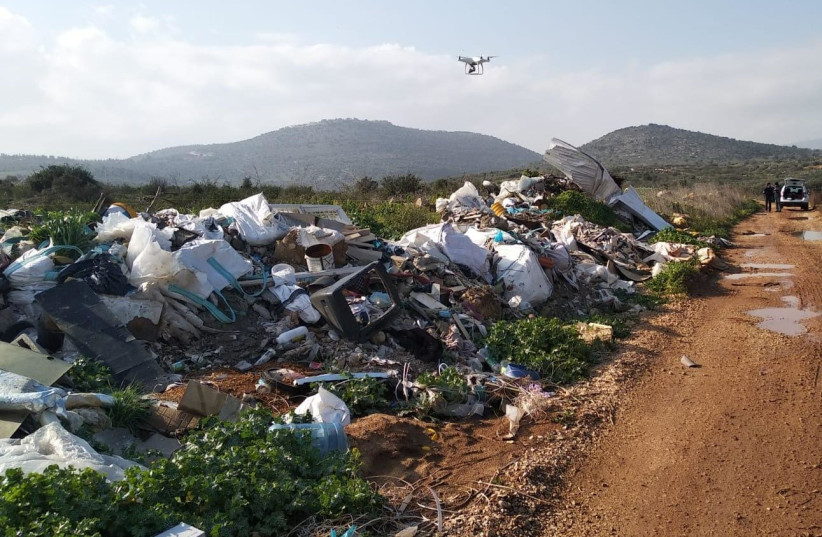Tel Aviv University has found another use for unmanned aerial vehicles – to map illegal waste dump sites.
Published: NOVEMBER 3, 2022

Drones are used to deliver missiles to enemies and hamburgers to customers. Now, for the first time in Israel, a pilot program conducted by Tel Aviv University (TAU) has found another use for these unmanned aerial vehicles – to map illegal waste dumps.
At present, local authorities dispose of their waste at authorized sites at a high financial cost. The TAU researchers – Dr. Vered Blass and doctoral student Adi Mager of its Porter School of Environment and Earth Sciences – have suggested that drones can map these sites from the air in order to recycle a considerable part of the waste and thus save the state a lot of money.
The researchers wanted to assess the actual amounts of construction waste dumped at unauthorized sites and the contents of the waste piles. Analysis of the data shows that through aerial mapping and the use of environmental-economic models developed in the study, it will be possible to recycle a significant amount of the waste and thus save the state a cumulative sum of some NIS 200 million.
“Around the world, two billion tons of waste was generated in 2016, and it is projected that the amount will increase by 70% by 2050 to reach 3.4 billion tons. Every day, governments and individuals make waste management decisions that impact the health, productivity and cleanliness of communities. Unmanaged waste contributes to air and water pollution, flooding and transmitting diseases while harming animals that unknowingly consume waste, and negatively affecting the economy,” they said.
“Our initial national estimates for the illegal waste cleanup based on the pilot results suggest that the treatment cost in Israel can be reduced by $58 million and even reach zero, with the potential to generate up to $82.8 million in profits,” they wrote. Their study was published in the international journal Remote Sensing under the title “From Illegal Waste Dumps to Beneficial Resources Using Drone Technology and Advanced Data Analysis Tools: A Feasibility Study.”

“Our study shows that by integrating existing aerial mapping technologies with economic-environmental models, we can promote recycling of illegal waste and save public funds,” Blass suggested. “Instead of paying landfill fees and polluting the soil, the waste may be recycled at a lower cost while reducing environmental damage.”
The researchers said that the current situation poses a severe problem for local authorities that are unable to handle the scope of criminal activity and thus forced to remove and treat the environmental hazard with their own money.
The moment a local authority identifies an illegal construction waste dump, it takes action to transfer the waste to an authorized site, the researchers said. This involves a complex process that includes measuring the amount of waste, collecting it, transporting it to the authorized treatment facility and then cleaning and rehabilitating the contaminated soil. This is an expensive process involving significant budgetary spending by municipalities, which usually passes the burden on to the taxpayers.
How was the study done?
THE STUDY involved the mapping by drones and analysis of four illegal waste dumps covering a total area of 3,600 square meters in northern Israel. The researchers studied all types of waste separately, by hand, to determine their area, volume and properties. Finally, they created a separate profile for each waste site that included an economic analysis of the value of the different types of waste found there and the potential environmental savings of recycling compared to landfilling.
“The idea behind the study was to try and adopt the principles of circular economy (CE) that promotes strategies for savings in resources for reuse, repair, remanufacture and recycling of materials and products,” Blass explained. “By using these principles, we sought to save the authorities a lot of money – instead of paying high landfill fees for all the illegal construction waste, which can be recycled.”
Their findings provide missing data that could prove useful to the state, local authorities, commercial companies, contractors and companies that monitor and manage recycled waste and raw materials. The researchers also noted the direct correlation between the meeting of international sustainable development goals (SDG), and monitoring and mapping illegal waste.
“This study will provide local authorities with a better understanding of the quantities and qualities of waste, as well as the costs associated with the necessary cleanups,” Mager said. “Moreover, construction waste in open areas occupies the valuable real estate. Mapping the area rapidly and efficiently will assist in evacuating the land and preparing it for future uses.”
Blass concluded that: “Our pilot findings showed the advantages of multidisciplinary tools and methodologies in helping to identify potential resources, providing economic data for cleanup proposals, and enabling the monitoring and evaluation of the area after the cleanup, thus saving time and money for the authorities, entrepreneurs and other stakeholders in the field.”
https://www.jpost.com/environment-and-climate-change/article-721361
